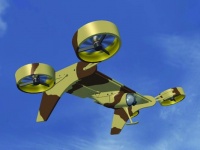
The concept and design for the aircraft is by VTOL Technologies, a small UK technology research and development firm based at SEEDA’s Reading Enterprise Hub.
The single fixed-wing aircraft – dubbed Flying Wing – would lift off the ground with four thrust vectoring ducted-fan units.
Ashley Bryant, managing director of VTOL Technologies, explained that once in the air, these units are designed to flip back, allowing the aircraft to fly forward at high speed. He added that the thrust can be controlled individually for each unit, giving the Flying Wing the ability to manoeuvre around tight spaces. These thrusters would also enable the aircraft to hover, launch from a moving vehicle or even use reverse thrust to land on a ship’s deck.
Bryant said those features would make the Flying Wing not only ideal for security monitoring at the London Olympics but also military operations such as those in mountainous Afghanistan.
Compared to other UAVs, Bryant claims the Flying Wing can work more aptly against wind gusts. This is due to the placement of outboard thrusters beyond the wing-tips. ’With this design because we have these fans beyond the wing-tip, we can respond to problematic wind gusts very quickly,’ he said.
The Flying Wing is expected to have a maximum flight time of two hours using lithium polymer cells as the power source. VTOL Technologies is currently looking into increasing the endurance by 50 per cent in the next two years with fuel-cell technologies.
VTOL Technologies has spent more than eight years designing and prototyping the Flying Wing, but Bryant said further development work will require additional funding.
In 2008, VTOL Technologies secured a six-month contract, worth more than £120,000 from the Ministry of Defence’s Centre for Defence Enterprise (CDE). The funding was not renewed last year due to MoD budget cuts.
Bryant is still confident he will receive development funding and when that happens it is likely his UAV will be ready for commercial deployment within 18 months.










Water Sector Talent Exodus Could Cripple The Sector
Maybe if things are essential for the running of a country and we want to pay a fair price we should be running these utilities on a not for profit...